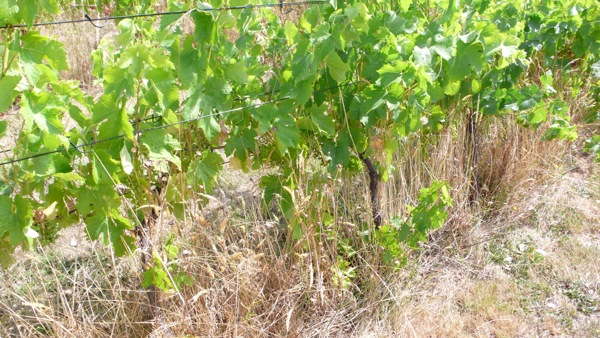Jay and I were excited about visiting the wineries on Vancouver Island this fall because when we’d last gone there two years ago, we’d had some surprisingly good wines, most of which are very difficult to find outside of the area. The wineries on the Island are mainly small-production, family-run places where the owner or another family member is also likely to be pouring your wine, so they’re good places to ask questions about the growing and production process.
Many of the wineries specialize in white wines, including unusual varieties like Ortega, a light white reminiscent of a Sauvignon Blanc with green-apple flavors; Pinot Auxerrois, an Alsatian grape similar to a Pinot Blanc but with more body and floral and citrus flavors; and Kerner, which resembles Riesling with flavors of apple and grapefruit but less acidity. These wineries also produce the more common Pinot Gris, Pinot Blanc, and Gewurtztraminer. The reds are very often Marechal Foch and Pinot Noir, which tend to grow well in this often-wet Maritime climate.
But what we quickly found this visit is that, sadly, the inconsistent weather on the Island results in some inconsistent wines. While the 2006 vintage that we tried in 2008 produced some nice wines, the 2008 vintage most wineries were tasting this year was harvested in a cold, wet year, resulting in some thin and flavorless wines. (Sadly, the 2010 vintage is looking to be much the same as the poor 2008, though the warmer 2009 growing season is showing potential.)
Out of the seven wineries that we visited, we only ended up buying two bottles: a 2009 Starling Lane Marechal Foch ($23.90) and a 2008 Glenterra Pinot Noir ($24). Here’s a rundown of the Vancouver Island wineries we visited and the Winederlust take on which are worth a visit or a pass. (Note that most of the Island wineries are only open for visits on weekends, with some open only during the summer months.)
Winederlust’s Favorite Vancouver Island Wineries
A small winery in an old farmhouse close to the Victoria airport, Starling Lane produces only one red – Marechal Foch – which it does very well, and a range of whites that include Ortega, Pinot Blanc, and Pinot Gris. Like some other Van Island wineries, they also produce a Blackberry Port ($22.90), which Jay and I found overly sweet.
A modern-looking, organically farmed winery with a restaurant attached called Thistles (though we didn’t have time to eat there, it has a delicious-looking menu that uses local ingredients). They only produce 750 cases a year, so many of their wines sell out. Though they specialize in Pinot Gris, Gewurtztraminer, and Pinot Noir, they also grow small quantities of 40 unique grapes in their “old vineyards” and use these in two very unusual, but tasty, blends – neither of which we could try since they were sold out. Their 2007 Brio VQA ($25), which we’d bought last time we visited, is a blend of 10 red grapes, including unusual varietals like Dunkelfelder and Haroldrebe Samtrot, while their 2009 Vivace ($20) mixes an astounding 17 grape varietals, including little-known Wurzer and Huxelrebe, into a delicious white wine.
We first tasted a Venturi Schulze wine when we dined at the Sooke Harbour House and became a little obsessed with their amazing Brandenburg No. 3, a sweet amber-colored wine with a surprising note of balsamic vinegar – not surprising when we discovered they also produce a fabulous balsamic vinegar itself. An organic winery, Venturi Schulze only produces wines from grapes grown on their estate, including such unusual varieties as Siegerrebe, Madeleine Sylvaner, and Zweigelt, which we didn’t see anywhere else we visited on the Island. All of their wines, while on the pricey side, were good, with many unusual flavors. For instance, the 2009 Terracotta ($32), a blend of Ortega and Siegerrebe, tasted of blue cheese. We also loved the 2007 Pinot Noir ($45), a richer than usual Pinot tasting of blackberries and spice.
Other Vancouver Island Wineries
The largest estate-grown winery on Vancouver Island with production of about 6,000 cases a year, Averill Creek grows Pinot Noir, Marechal Foch, Pinot Gris, and Gewurtztraminer, and sits on a hill with lovely views of the vineyards below. Though we greatly enjoyed their wines when we visited in 2008, we didn’t find their new vintages – the 2008s and 2009s – as appealing this time around.
This winery, which uses no pesticides or herbicides in the growing process, expands on some of the Island’s more traditionally grown grapes with Bacchus (a cross of Riesling and Sylvaner), Chardonnay, and Pinot Gris for the whites, and Pinot Noir, Marechal Foch, and Gamay for the reds. The only wine we really enjoyed here was the 2005 Pinot Noir Reserve ($25), a big, well-balanced red, but we found that many of the others had a strong and unappealing yeasty taste and, in the case of the unfiltered 2009 Pinot Grigio, was even cloudy. As our tasting room wine pourer here told us, “The owner doesn’t really care what other people think.”
The first commercial vineyard on Vancouver Island, Zanatta grows more than 40 varieties in limited quantities, though they specialize in Ortega, Cayuga, Auxerrois, Pinot Grigio, Pinot Nero, and Madeleine Sylvaner. Zanatta also makes a large number of sparkling wines. Unfortunately, we weren’t fans of many of the wines we tasted here, finding them either too sweet, undeveloped, or skunky tasting.
Though recommended if you’re looking for a pretty place to eat – we had a very enjoyable lunch amongst the vineyards when we visited two years ago – without the food, we weren’t as impressed by the wines this time. They included a strange Hungarian varietal called Agria with a leathery, anise taste, and not terribly exciting estate-grown Pinot Gris, Gewurtztraminer, Ortega-Siegerrebe, and Pinot Noir, as well as overly sickly-sweet blackberry dessert wines.


